We’re on the brink of one of the biggest technological advancements of our lifetime — AI. For the first time in twenty years, we have a blank canvas, complete artistic freedom to reimagine everything in B2B software.
At this year’s SaaStr Annual, Mark Roberge, co-founder and Managing Director of Stage 2 Capital, takes the stage to have a bake-off between startups and incumbents when it comes to who will win the AI Go-to-Market race.
The question entrepreneurs and founders need to ask themselves is…
Is Your Company Still Relevant In A Post-AI World?
It’s an exciting time to be a visionary, and that’s a founder’s job. As a visionary, you have to think about what a post-AI world looks like 5-10 years from now and imagine what the use case you’re solving for now looks like in that world.
Otherwise, you’re facing irrelevance.
We’re also potentially in a hype cycle. There is a close parallel between how the internet disrupted society and software and how AI will, too. If the internet rolled out in 1997, then our current hype cycle is what it was like in 1998.
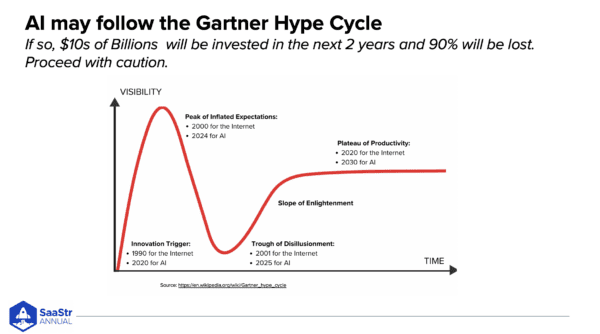
It was the new economy, and all the Goldman Sachs and McKinsey people quit their jobs, becoming CEOs of disruptor businesses with iterative ideas like putting the news or company brochures online. No one could see Snowflake or Uber yet, and society wasn’t ready either.
The early adopters didn’t win either. Look at AOL and Netscape for the internet. Those companies are gone. We’re seeing similar early signals today with crazy valuations and iterative technologies, and embedding AI into workflows today isn’t disruption.
An AI Strategy that Doesn’t Die in the Hype Cycle
You have to think big about your vision. You don’t want an AI strategy that’s really just an iteration that will die in the hype cycle. But how do you achieve true disruption that sustains the next few decades?
The Innovator’s Dilemma.
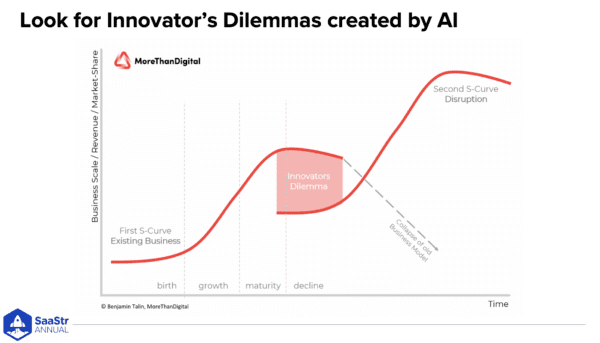
The Innovator’s Dilemma is the long-time work of Clayton Christensen, a Professor at Harvard Business School. He proved that the innovator’s dilemma causes big companies to get disrupted.
The premise is that big companies ride the iterative disruptive wave and get so big that they have to sell big products for big profits. Then, along comes a new disruptive technology that doesn’t represent a big market, and these big companies ignore them because they’re too small or will disrupt their business.
So, consider what the innovator’s dilemma is today as you rethink your startup in an AI-first world in a hyper cycle.
How do you not get hyped and make it through the hype cycle?
Design Big But Start Small
You go to the mountain and rethink your business in a post-AI world. That’s hard to do, especially being in a hype cycle. So, you have to think bigger than you actually are. But if you come up with a big vision and figure out a true displacement business model for ten years from now, the market won’t be ready for it.
You will have no customers. If you work on what you’re doing now, it gets disrupted in 10 years. If you focus on ten years ahead, you won’t have any customers now. It’s a conundrum.
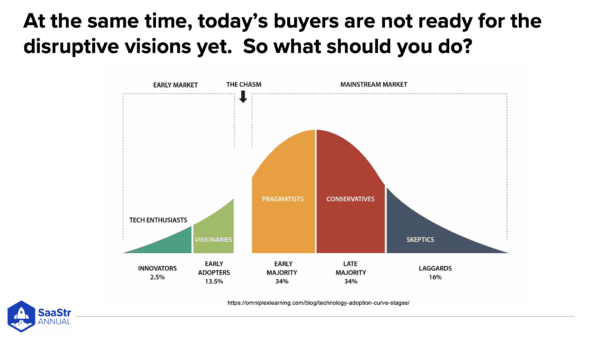
The key is to design big but start small. You don’t have to solve for a huge market right out of the gate. Build the MVP to get you to $10M. Then, test it and scale it for a couple of years. Take another three years to test the next market or product and get to $50M.
The ideas you have today are going to get disrupted. You need the big idea the market isn’t ready for today, and then you start small on your way towards it, waiting for the market to become ready.
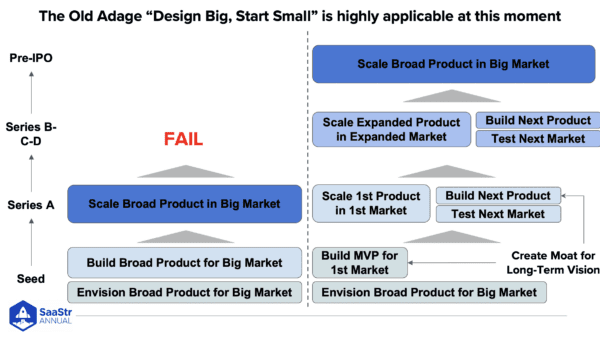
Jeff Bezos Didn’t Set Out To Sell Books
Jeff Bezos didn’t set out to be a book salesman, but that was the first product. He saw the internet was crazy and knew all commerce would be disrupted. He knew people would order everything from clothes to food online, and he wanted to be the one selling it.
But he didn’t start out selling everything. He made a list of 50 things to sell, and books were first because they had high margins and millions of titles, and it was a low-risk online purchase for people who didn’t trust putting a credit card in or buying clothing without trying them on first.
He created a moat for a long-term vision and spent years selling books. This all helped with operational rigor. All the warehouses and delivery mechanisms were being iterated, and Wal-Mart couldn’t catch up.
Steve Jobs did the same thing. He had the vision but started with music. Which just so happened to be the number two item on Bezos’s list.
Some of the most valuable companies in the world started with the advent of huge technological disruption. That’s the opportunity ahead of us.
Startups vs. Incumbents
To beat out incumbents, you need good data. Data acquisition will become an important function within the business development domain. When choosing an opening beachhead unique to AI, choose use cases where big company incumbents don’t have the data.
It’ll stack the deck in your favor.
What about talent?
Tremendous research shows that top engineering talent prefers startups over big companies. They don’t care as much about maximizing their salary income. They care about working on cool technology with little red tape to deploy it.
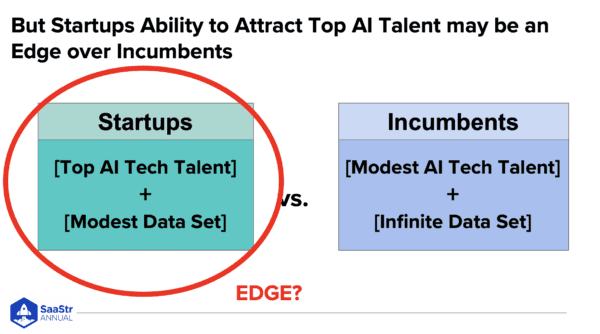
This happens at startups and not big companies. So, who wins? Big companies with all the data and mediocre AI tech talent, or startups with the best AI tech talent and less data?
Many believe the startups would win because of diminishing returns. And there are plenty of ways to acquire more data when you aren’t a big company.
So, you have to think bigger, go to the mountain, and understand that we’re in a hype curve, but the market isn’t ready for the big idea. Now, you have this beachhead where the incumbent doesn’t have the data, and you can create a moat around that data you have access to.
Time Is The Startup’s Competitive Advantage
Stage 2 Capital ran an experiment where they discovered that many companies liked the current GTM AI tech coming out but couldn’t use it because security teams didn’t know how to deal with it. They were going to wait.
This is good news for startups because it means the incumbents will wait. Big companies with billion-dollar marketing budgets, 10k employees, and 20 years of engineering development drive aircraft carriers. They take so much energy to turn just 5 degrees.
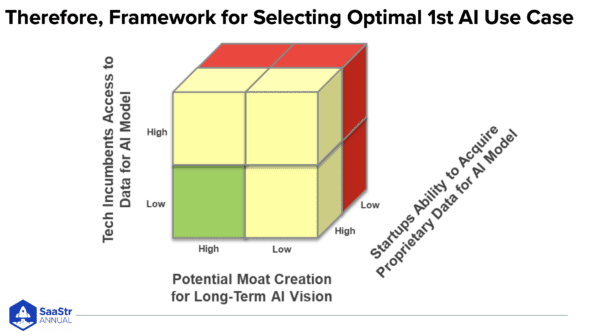
Startups are piloting F15 fighter jets that turn on a dime during the biggest technological advancement in our lifetime.
Entrepreneurship is hard, but you have a competitive advantage if you…
- Reimagine your company in a post-AI world.
- Distinguish between hype and disruption.
- Pursue a big vision.
- Know the market isn’t ready
- Sequence your product development.
- And target the market accordingly.
Key Takeaways
- The emergence of AI as a Major Technological Shift: AI is viewed as a significant technological advancement, offering a chance to completely reimagine B2B software.
- Relevance in a Post-AI World: Companies, especially startups, need to assess their relevance in a future dominated by AI. This involves envisioning the future landscape 5-10 years ahead and adapting their solutions to fit into that scenario.
- Risk of Irrelevance and Hype Cycle: The current period might be akin to a “hype cycle,” similar to the early days of the internet. Companies should be cautious of becoming irrelevant or getting lost in the hype.
- Innovator’s Dilemma: The concept, introduced by Clayton Christensen, highlights the challenge big companies face in adapting to disruptive technologies. Startups need to understand this dilemma and position themselves accordingly in an AI-first world.
- Strategy for AI Integration: The goal is to develop a visionary AI strategy that avoids being a mere iteration and survives beyond the hype cycle. This involves balancing long-term vision with immediate practical steps.
- Start Small, Plan Big: Companies should aim for grand visions but start with small, manageable projects. This approach helps in building towards a bigger goal while staying relevant in the current market.
- Examples of Successful Strategies: Jeff Bezos with Amazon and Steve Jobs with Apple are cited as examples of starting with focused, small-scale projects (books and music, respectively) while keeping a larger vision in mind.
- Startups vs. Incumbents: Startups might have an edge over incumbents due to their agility, access to top AI talent, and ability to innovate rapidly. The challenge for startups is to acquire and leverage data effectively.
- Advantage of Time for Startups: Startups, being more agile and adaptable, can navigate the AI-driven landscape more quickly compared to larger, more established companies.
- Reimagining Business Models: Entrepreneurs are encouraged to reimagine their companies in a post-AI world, distinguishing between mere hype and true disruption, and strategically sequencing their product development.

